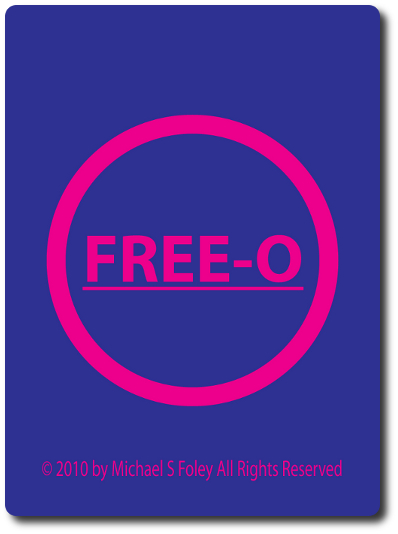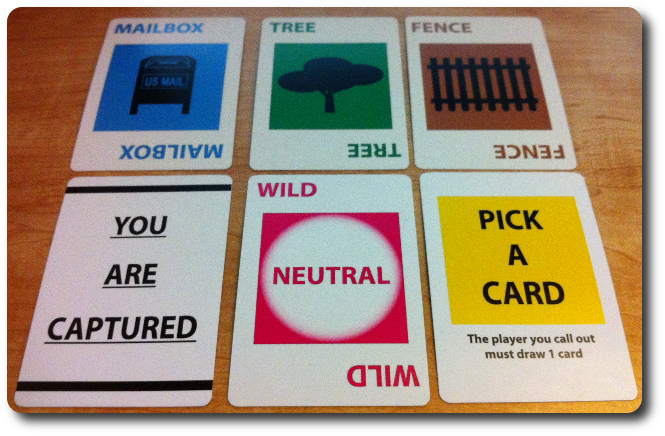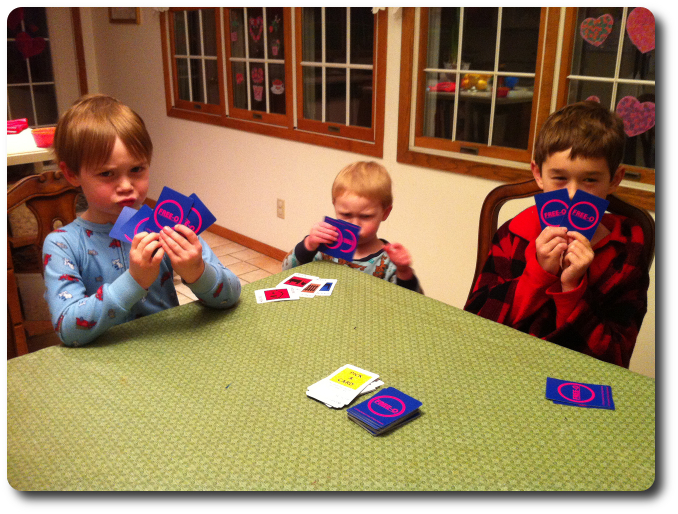
The Basics:
- For ages 8 and up (publisher suggests 12+)
- For 2 to 8 players
- Variable game length
Geek Skills:
- Active Listening & Communication
- Counting & Math
- Logical & Critical Decision Making
- Reading
- Pattern/Color Matching
- Hand/Resource Management
Learning Curve:
- Child – Easy
- Adult – Easy
Theme & Narrative:
- None
Endorsements:
- Gamer Geek rejected!
- Parent Geek approved!
- Child Geek approved!
Overview
The game of Hide-And-Seek is as old as the first day a single-celled organism tried to avoid another in a pool of primordial soup. Today, we play Hide-And-Seek in hopes of outwitting and out-thinking our opponent, not because we are avoiding capture and absorption, but the premise is the same. Be caught and lose, or stay one step ahead and win! In this game, you are going to attempt to do just that!
FREE-O, by Foley Games, is comprised of 90 cards. Within the cards are 9 specific locations the players are going to look in an attempt to find their opponents. The locations include the house (14 cards), the car (7 cards), the truck (7 cards), the bushes (8 cards), in the tree (8 cards), behind the fence (10 cards), in the garage (4 cards), behind the rock (4 cards), or behind the mailbox (4 cards). The deck of cards also includes a “Wild” card (12 cards) that can match anything, an action card that makes players draw cards (6 cards), and a capture card that automatically “finds” a player unless they can skillfully avoid it (6 cards). The artwork on the cards is very minimalistic and the text is minimal. Not included in the game, and not necessarily needed to play (depending on how the players want to keep score or not) is a pen or a pencil and a piece of paper.

Game Set Up
To set up the game, first take the cards and give them a really good shuffle.
Second, deal out to each player 6 cards, face-down. Players should look at their cards but keep them hidden from their opponent’s at all times.
Third, place the remaining cards, face-down, in the middle of the playing area. This is the draw deck.
Fourth, take the top card of the draw deck and flip it over, face-up, placing it next to the draw deck. This is the first card in play and also creates the discard pile.
That’s it for game set up. Time to capture your opponents!
Hiding and Seeking
The game is played in rounds with players taking many turns in a single round. The round ends when the end of round condition is met. A single game can contain one or more rounds.
On a player’s turn, they will play one or two cards to the discard pile to react to a card previously played. For the first player of the round, they will be playing to the card drawn from the draw deck. All other players will be playing to the card on the top of the discard pile. Turn order is clockwise.
The goal of the game is to “capture” your opponent to your left, which forces them to draw cards. This is done by playing a card that cannot be matched. A player’s turn is referred to as “Seek and Match”.
The most numerous cards in the player’s hand are the location cards (mailbox, bushes, trees, etc.). All the location cards have a specific color, have a unique image, and are labeled. If the player can play a matching location, a Wild card, or a “You are Captured” card, they have not been found. If not, they draw 1 card from the draw deck and add them to their hand. Regardless, play then passes to the next player who must match the card on the top of the discard pile.
If the player plays a “Wild” card, it automatically matches any location card and allows the player to automatically play another card from their hand. A player can only play 1 Wild card on their turn and the “Wild” card cannot be the last card played to end the round. “Wild” cards played against a “You Are Capture” card do NOT allow the player to play another card, but the next player can play whatever card they want.
If the player plays a “You Are Captured” card, it can be placed over any card previously played. The next player can only avoid being captured if they play a “Wild” card (which ends their turn). If the next player cannot, they draw 2 cards from the draw deck and add them to their hand. Play then passes to the next player who must also play a “Wild” card or draw 2 cards. This continues until a player can play a “Wild” card, including the player who originally played the “You Are Captured” card!
The “Pick a Card” card can only be played to start a new “Seek and Match” set. The “Pick a Card” can target ANY player, not just the next player in turn order. There is no way to avoid this card other than being really nice to everyone at the table in hopes of not being a target. Play then continues with the next player in turn order who can play any card they like.
End of the Round and the End of the Game
A game round ends when a player plays their last card. A player’s last card cannot be a “Wild” card. If a player plays the “You are Captured” as their last card, the next player in turn order must play a “Wild” card or draw 2 cards to be added to their hand and ending the round. Any other card played simply ends the round with the next player in turn order not taking their turn.
All players now look at the cards left in their hand and count points. Collecting points is not a “good thing” in this game. The points the player counts is dependent on the cards they have not been able to play.
- “You are Captured” cards are 10 points each
- “Seek and Match” cards (locations) are worth 2 points each
- “Pick A Card” cards are worth 1 point each
- “Neutral Wild” cards are worth – 1 point each
A new round now begins and the game is set up as described above. Make sure each round has a new dealer.
The game ends when one or more players have collected 60 or more points. The player with the least amount of points is the winner.
Players also have the option of not counting points at all. A game could be completed in a single round with the winner being the player who plays their last card. Or, if the players prefer, several rounds can be played and the winner of the game is the one who ended the round the most times. How the game is scored and the winner determined is very much up to player preference.
To learn more about FREE-O and read the full rules, visit the game’s web page at the Game Crafter.
Prediction
FREE-O is similar to UNO, another card game my little geeks and our family enjoys playing together. Because of the similarities in game play and the overall “feel” of the game, I have no doubt it will do well with the Child Geeks and the Parent Geeks. I doubt very much the Gamer Geeks will do much with this game other than to acknowledge that it is casual, light, and not at all a “gamer’s game”.
What I find interesting is that the location cards are not of equal number and some are impossible to evenly match. For example, the truck location card only has 7 in total. That means you will always have 1 truck location card you cannot match in a round. While I doubt the average player will count the cards being played, knowing that the location cards are not overly abundant or equal in number does add an interesting twist.
Teaching the game is very easy and all it took for our players is one turn each to fully understand how the game is played. I suggest you spend just a moment to describe the “Seek and Match” sets to ensure that all players know that it is perfectly possible that a card they play on their turn could come back around to bite them in the bud! Believe me, it can and will happen.
And so, after showing the game to my 8-year-old and my 5-year-old, answered their questions, and demonstrated a “Seek and Match” set, we were ready to play. As my 5-year-old shuffled the cards, I asked them their thoughts on the game so far.
“An easy game of matching cards and avoiding cards. I like it. Reminds me of UNO.” ~ Liam (age 8)
“I like how it’s like Hide-And-Seek. FOUND YOU, DADDY!” ~ Nyhus (age 5)
My little geeks are ready to go and play a subtle game of ducking and dodging with cards. Let’s get to it and see if we find fun or it remains elusive at our gaming table.
Final Word
The game was very well received by the Child Geeks, with much laughter, sighs of frustration, and dramatic fist shaking. Child Geeks as young as 8-years-old can play this game with no help. Our youngest player, at age 5, was able to play the game, but with occasionally assistance. Help was needed at times to read the “You are Captured” and “Pick a Card” cards only. The 5-year-old had no problem playing cards for matches (they just used the pictures and the colors). Indeed, the 5-year-old even won a number of rounds. But because other players did have to read a card for them, we cannot recommend this game to any player younger than 8-years-old or for any player who cannot yet read. Regardless of reading skill, all the Child Geeks enjoyed the merry chase of Hide-And-Seek with the cards and enthusiastically approved FREE-O.

My little geeks stealthily hide behind their cards, ready to pounce!
Parent Geeks also enjoyed it. They found FREE-O to be light, casual, and fast. All important aspects of a good game to the Parent Geeks who are primarily casual to exceedingly casual game players. The Non-gamers had no problem learning and competitively playing the game, too, which is a real plus. Considering the number of players the card game can take (a total of 8), a typical game can have a good mix of Child, Parent, and Gamer Geeks at the table. Because of the large number of players the game allows and being a fun and fast game to play with the family or friends, the Parent Geeks approved FREE-O. The only note of disapproval I heard from the Parent Geeks was a bit of grumbling from them when points were counted. They would have preferred that all cards had a number to indicate how much each was worth. This would make it easier to count points at the end of the game and to know which cards to get rid of as soon as possible while playing the game. An excellent point.
Gamer Geeks sat around the table, played the game with ease, and rolled their eyes when the Parent and Child Geeks started to wax poetically about how terrific the game was. To the Gamer Geeks, they didn’t think the game had any depth and was nothing more than a very light game filler, at most. And by “at most”, the Gamer Geeks really meant “never”. FREE-O is not a game a Gamer Geek would naturally gravitate to or suggest. It’s not that the Gamer Geeks found FREE-O to be a bad game, but nor did they think it was a game they wanted to bother with when there are so many other card games that have depth and make use of interesting strategies and tactics available to them. As such, the Gamer Geeks did not endorse it.
FREE-O is fun for the family and is most certainly a very solid “family game”. It isn’t a game I would bring to one of my Gamer Geek Game Night (patent pending), but nor is it a game I would turn down if someone wanted to play it with me. And in the interest of full disclosure, I rather like UNO which is a game very much like FREE-O. Like, but not identical. UNO has a lot more card options, but they all tend to stop after being played. FREE-O has less card options, is harder to match, and a single card play can result in a whirlwind of card collecting that cannot be stopped by anyone. An interesting story on that last point…
During one of our games, a player (a Gamer Geeks, to be specific) played the “You Are Captured” card. The player to their left could not match or avoid it, so they were forced to take 2 cards. The next player in turn couldn’t match it either, so they had to take 2 card. Then the next player couldn’t match it, so they had to take 2 cards. It then came back to the Gamer Geek who initially played it who, you guessed it, couldn’t match it so he had to take 2 cards, too. This continued for a total of 10 turns, if I counted correctly. No one at the table was particularly happy with the Gamer Geek who looked positively pleased with himself.
Is FREE-O worth it? Sure, if you like easy to play card games. It can be pretty fun, even for an old Gamer Geek like myself. The speed of the game play is pretty fast, but it can feel bogged down if you have to keep drawing cards. The game is also great for the Child Geeks if they are just starting to read and you want to introduce a light game that requires some critical thinking to play, but not enough to make it a painful exercise. Well, painful for the Gamer Geeks, but they can suck it up for the sake of a fun family game night.
This game was given to Father Geek as a review copy. Father Geek was not paid, bribed, wined, dined, or threatened in vain hopes of influencing this review. Such is the statuesque and legendary integrity of Father Geek.



